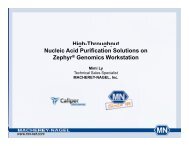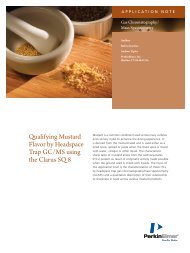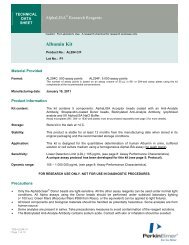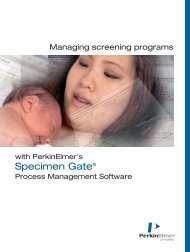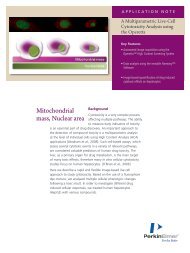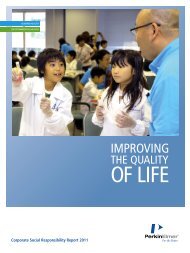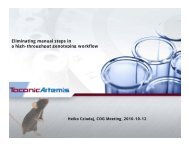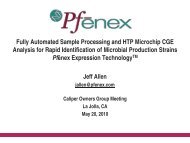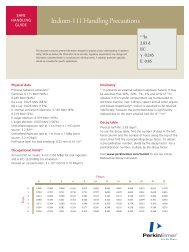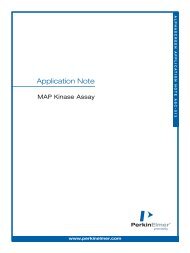AlphaLISA Assay Development Guide - PerkinElmer
AlphaLISA Assay Development Guide - PerkinElmer
AlphaLISA Assay Development Guide - PerkinElmer
You also want an ePaper? Increase the reach of your titles
YUMPU automatically turns print PDFs into web optimized ePapers that Google loves.
PERKINELMER, INC.<br />
<strong>AlphaLISA</strong> ®<br />
<strong>Assay</strong> <strong>Development</strong> <strong>Guide</strong><br />
For Laboratory Use Only<br />
Research Chemicals for Research Purposes Only<br />
M-6772001/2/3/4-04
TABLE OF CONTENTS<br />
I. BEFORE STARTING....................................................................................4<br />
II. INTENDED USE ...........................................................................................6<br />
III. PRINCIPLE OF THE ASSAY .......................................................................7<br />
IV. ASSAY DEVELOPMENT .............................................................................7<br />
A. Selection of antibody pairs .............................................................................................. 8<br />
B. Biotinylation of the antibody ............................................................................................ 9<br />
C. <strong>AlphaLISA</strong> acceptor bead conjugation with the antibody................................................ 9<br />
D. Determination of the best antibody pair ........................................................................ 13<br />
E. <strong>Assay</strong> buffer optimization .............................................................................................. 18<br />
F. Optimization of the assay volume, incubation time and order of addition..................... 19<br />
G. Determination of the level of analyte in unknown samples by interpolation from the<br />
calibration curve ............................................................................................................ 19<br />
V. REFERENCES ...........................................................................................23<br />
Appendix I: Summary of <strong>AlphaLISA</strong> <strong>Assay</strong> <strong>Development</strong> Steps..................24<br />
Appendix II: Serum Sample Preparation........................................................25<br />
- 2 -
Precautions<br />
• Alpha streptavidin-coated Donor beads (referred in this guide as streptavidin<br />
Donor beads) are light-sensitive. All assays using the streptavidin Donor<br />
beads should be performed under subdued laboratory lighting of less than<br />
100 lux. Alternatively, green filters (e.g., Roscolux filters #389 from Rosco<br />
Laboratories, Inc., or equivalent) can be applied to light fixtures. Any<br />
incubation of streptavidin Donor beads should be performed in the dark.<br />
• Due to the small volumes used in the assay, it is recommended to cover<br />
microplates with TopSeal-A TM adhesive sealing film to reduce evaporation<br />
during incubation periods (<strong>PerkinElmer</strong>, Inc., Cat. No. 6005185). The<br />
microplates can be read with the TopSeal-A film in place, except if<br />
condensation is present.<br />
• <strong>AlphaLISA</strong> Acceptor beads in the stock solution may slightly sediment over<br />
several days. This is normal. It is advised to vortex the beads prior to use.<br />
• Streptavidin Donor beads and <strong>AlphaLISA</strong> Acceptor beads should be stored in<br />
the dark at 4 o C.<br />
• <strong>AlphaLISA</strong> is intended for research purposes only and is not for use in<br />
diagnostic procedures.<br />
- 3 -
I. BEFORE STARTING<br />
Receiving the <strong>AlphaLISA</strong> Acceptor Beads<br />
Upon receiving the <strong>AlphaLISA</strong> Acceptor beads, ensure that they are on blue<br />
ice and that the ice packs are not completely thawed.<br />
Reagents Provided<br />
The following sizes are available:<br />
1 mg (catalog number 6772001)<br />
5 mg (catalog number 6772002)<br />
50 mg (catalog number 6772003)<br />
Bulk format (catalog number 6772004)<br />
Table I: Reagents provided<br />
COMPONENT<br />
1 mg<br />
6772001<br />
5 mg<br />
6772002<br />
50 mg<br />
6772003<br />
<strong>AlphaLISA</strong> Acceptor beads<br />
stored in 0.1M Tris-HCl pH 8.0,<br />
0.05% Proclin-300<br />
50 µL<br />
(20 mg/mL)<br />
250 µL<br />
(20 mg/mL)<br />
5 x 500 µL<br />
(20 mg/mL)<br />
Notes before use<br />
• For maximum recovery of contents, briefly spin the vials prior to<br />
removing the caps and resuspend the beads by vortexing.<br />
• <strong>AlphaLISA</strong> Acceptor beads should be stored at +2 to +8°C.<br />
- 4 -
Recommended Additional Reagents and Materials<br />
Table II: Recommended reagents and materials<br />
Item Suggested source Catalog #<br />
AlphaScreen<br />
Streptavidin-coated Donor beads<br />
<strong>PerkinElmer</strong>, Inc.<br />
Analyte of choice N/A N/A<br />
Pair of anti-analyte antibodies N/A N/A<br />
6760002S (1 mg)<br />
6760002 (5 mg)<br />
6760002B (50 mg)<br />
Microplate <strong>PerkinElmer</strong>, Inc. see Table III<br />
TopSeal-A Adhesive Sealing Film <strong>PerkinElmer</strong>, Inc.<br />
6005185 (pack size of<br />
100 pieces)<br />
Single-channel pipettors § N/A N/A<br />
NHS activated biotinylating reagent<br />
(ChromaLink)<br />
Carboxymethylamine<br />
hemihydrochloride (CMO)<br />
SoluLink Inc. B1001-105<br />
Sigma-Aldrich Co.<br />
C13408<br />
Sodium cyanoborohydride Sigma-Aldrich Co. 152159<br />
Zeba desalting columns<br />
Pierce<br />
(ThermoFisher Scientific<br />
Inc.)<br />
89882 (0.5 mL)<br />
89889 (2 mL)<br />
89891 (5 mL)<br />
89893 (10 mL)<br />
Proclin-300 Sigma-Aldrich Co. 48912-U<br />
Tween-20<br />
(Surfact-Amps 20)<br />
Dextran 500<br />
MW ~500000<br />
Pierce<br />
(ThermoFisher Scientific<br />
Inc.)<br />
Sigma-Aldrich Co.<br />
28320<br />
D1037<br />
Casein<br />
5% Alkali-soluble solution<br />
Novagen<br />
(EMD Chemicals Inc.)<br />
70955<br />
Triton-X100<br />
(Surfact Amps X100)<br />
Pierce<br />
(ThermoFisher Scientific<br />
Inc.)<br />
28314<br />
Streptavidin-Sepharose beads GE Healthcare, Inc. 17-5113-01<br />
§<br />
For lower volume additions (< 10 μL), we recommend a pipettor precision of ≤ 2%. For higher<br />
volume additions (25-1000 μL), a pipettor precision of ≤ 1% is recommended.<br />
- 5 -
Table III: Microplates<br />
<strong>Assay</strong><br />
Format<br />
96<br />
384<br />
1536<br />
Microplate Catalog # § well<br />
Total<br />
volume<br />
Recommendations<br />
OptiPlate-96 6005290 400 µL Ideal for assay volume ≥ 50 µL<br />
½ AreaPlate-96 6005560 180 µL<br />
Ideal for assay volume of 50 µL in<br />
96-well format<br />
ProxiPlate-96 6006290 100 µL Not recommended<br />
OptiPlate-384 6007290 105 µL<br />
AlphaPlate-384 6005350 105 µL<br />
ProxiPlate-384 6008280 30 µL<br />
AlphaPlate-1536 6004350 12 µL<br />
OptiPlate-1536 6004290 12 µL<br />
§<br />
For 50 plates; refer to <strong>PerkinElmer</strong>, Inc. website for other quantities<br />
Good for assays of 25-50 µL in<br />
384-well format<br />
Ideal for high-count assays of 25-<br />
50 µL in 384-well format (lower<br />
cross-talk than OptiPlate-384)<br />
Good for assays of 10-25 µL in<br />
384-well format<br />
Ideal for assays of 5-10 µL in<br />
1536-well format (lower cross-talk<br />
than OptiPlate-1536)<br />
Not recommended for <strong>AlphaLISA</strong><br />
due to higher cross-talk<br />
The protocols included in this manual are for OptiPlate-384 microplates.<br />
Other plate types listed in Table III may be used with the appropriate assay<br />
volume.<br />
<strong>Assay</strong>s must be read using an AlphaScreen-compatible reader such as all<br />
EnVision ® multilabel plate readers with an AlphaScreen module, the Fusion-<br />
Alpha multilabel reader or the AlphaQuest ® original AlphaScreen reader<br />
(<strong>PerkinElmer</strong>, Inc.). The normal AlphaScreen settings should be used.<br />
II.<br />
INTENDED USE<br />
The <strong>AlphaLISA</strong> Acceptor beads are intended to perform biomarker<br />
detection (referred in this guide as analyte), protein-protein<br />
interaction, intracellular target detection assays or any other<br />
biological detection assay. <strong>AlphaLISA</strong> is for research purposes only<br />
and not for use in any diagnostic procedures.<br />
- 6 -
III. PRINCIPLE OF THE ASSAY<br />
The <strong>AlphaLISA</strong> technology allows the detection of molecules of interest in<br />
serum, plasma, cell culture supernatants or cell lysates in a very sensitive,<br />
quantitative, reproducible, and user-friendly assay. Almost, any sandwich<br />
assay can be developed to detect an analyte of interest. As shown in Figure<br />
1, an anti-analyte antibody which is biotinylated binds the streptavidin Donor<br />
bead while another anti-analyte antibody is conjugated to <strong>AlphaLISA</strong><br />
Acceptor beads. In the presence of the analyte, the beads come into close<br />
proximity. The excitation of the Donor beads provokes the release of singlet<br />
oxygen molecules that triggers a cascade of energy transfer in the Acceptor<br />
beads, resulting in light emission. For more details about the <strong>AlphaLISA</strong><br />
technology, please refer to the guide entitled ‘A Practical <strong>Guide</strong> to Working<br />
with AlphaScreen’.<br />
Figure 1: Illustration of the detection of an analyte (insulin in this example)<br />
using <strong>AlphaLISA</strong> Acceptor beads<br />
IV. ASSAY DEVELOPMENT<br />
A few simple steps are needed to develop an <strong>AlphaLISA</strong> analyte assay.<br />
This generic protocol is the starting point for the development of all<br />
<strong>AlphaLISA</strong> assays. Some assays may require modified protocols based on<br />
the specific nature of the analyte under investigation.<br />
- 7 -
A. Selection of antibody pairs<br />
To develop an <strong>AlphaLISA</strong> analyte detection assay, an antibody pair that<br />
recognizes the targeted analyte is required. It is always preferable to find<br />
an antibody pair that has already been tested in a sandwich assay. Most<br />
of the identified pairs should perform well in <strong>AlphaLISA</strong>. If no identified<br />
pairs are available, different antibodies need to be tested to find a pair<br />
that will perform optimally in <strong>AlphaLISA</strong>. All antibodies must be selected<br />
according to the following guidelines:<br />
• Each antibody should recognize a different epitope on the analyte.<br />
• The two antibodies must be specific to the analyte.<br />
• Monoclonal or purified polyclonal antibodies will perform best; avoid<br />
the use of anti-sera.<br />
• The antibodies must not be in any amine-based buffer, including Tris,<br />
glycine, bicine, tricine, etc. If buffer exchange is necessary, the buffer<br />
should be replaced with a neutral to slightly alkaline buffer, such as<br />
PBS or carbonate buffer pH 8.<br />
• Antibody solutions must not contain any protein or peptide-based<br />
stabilizers (such as BSA or gelatin).<br />
• Optimal results will be obtained with antibody concentrations above<br />
0.5 mg/mL.<br />
One of the two antibodies will have to be biotinylated and the other one<br />
should be conjugated to <strong>AlphaLISA</strong> Acceptor beads. It is recommended<br />
to test the two possible combinations as the sensitivity and the level of<br />
counts may differ dramatically depending on the set-up. The two<br />
combinations are as follows:<br />
1. biotinylated antibody A + antibody B-<strong>AlphaLISA</strong> Acceptor beads<br />
2. biotinylated antibody B + antibody A-<strong>AlphaLISA</strong> Acceptor beads<br />
Therefore, it is recommended to biotinylate both antibodies of the pair as<br />
well as conjugating both to <strong>AlphaLISA</strong> acceptor beads to eventually<br />
select the optimal assay configuration.<br />
(Note: Alternatively, the antibodies can be captured in an indirect assay<br />
set-up using anti-species IgG <strong>AlphaLISA</strong> Acceptor beads and/or<br />
biotinylated anti-species IgG. See <strong>AlphaLISA</strong> products on p. 24.)<br />
- 8 -
B. Biotinylation of the antibody<br />
The following protocol is used for biotinylation of antibodies:<br />
a. A preliminary check of the antibody to be biotinylated is mandatory.<br />
The User must check for the following:<br />
• The biotinylation will perform best when the antibody<br />
concentration is at least 0.5 mg/mL.<br />
• The antibodies must not be in any amine-based buffer, including<br />
Tris, glycine, bicine, tricine, etc. If buffer exchange is necessary,<br />
the buffer should be replaced with a neutral to slightly alkaline<br />
buffer, such as PBS or carbonate buffer pH 8. Optimal<br />
performance will be obtained in sodium azide-free conditions.<br />
• Antibody solutions must not contain any protein or peptide-based<br />
stabilizers (such as BSA or gelatin).<br />
• The antibody will be labeled at slightly alkaline pH values (7.0-8.0)<br />
in aqueous buffer. Ensure that the antibody is soluble in these<br />
conditions.<br />
b. Prepare antibody solution. If the antibody is provided in a powder<br />
form, resuspend at 5 mg/mL in PBS. If already in solution at neutral<br />
to slightly alkaline pH (pH ≥ 7.0), use as provided.<br />
c. On the day of the assay, prepare a fresh solution of<br />
N-hydroxysuccinimido-ChromaLink-biotin (NHS-ChromaLink-biotin)<br />
at 2 mg/mL in PBS. Alternatively, other NHS reagents such as NHSbiotin,<br />
NHS-LC-biotin or NHS-LC-LC-biotin can also be used.<br />
d. Add NHS-ChromaLink-biotin to the antibody solution. A 30:1 molar<br />
ratio of biotin to antibody is recommended. This represents using 7.6<br />
µL of a 2 mg/mL NHS-ChromaLink-biotin solution for 100 µg of<br />
antibody. Adjust the volume to 200 µL with phosphate buffer pH 7.4.<br />
e. Incubate for 2 hours at 21-23ºC.<br />
f. When using NHS-ChromaLink-biotin, a purification step using Zeba<br />
columns is required to remove free biotin. To evaluate biotinylation<br />
efficiency, refer to SoluLink’s website (http://solulink.com).<br />
C. <strong>AlphaLISA</strong> acceptor bead conjugation with the antibody<br />
C1. Preliminary Notes<br />
A preliminary check of the material to be conjugated is mandatory. The<br />
User must check for the followings:<br />
• The conjugation will perform best when the antibody<br />
concentration is at least 1 mg/mL (when conjugating 1-2 mg of<br />
- 9 -
eads) or 0.53 mg/mL (when conjugating 2.5 mg of beads or<br />
higher amounts). Lower concentrations of antibody yield lower<br />
coupling efficiency.<br />
• The antibodies must not be in any amine-based buffer, including<br />
Tris, glycine, bicine, tricine, etc. If buffer exchange is necessary,<br />
the buffer should be replaced with a neutral to slightly alkaline<br />
buffer, such as PBS or carbonate buffer pH 8. (Note: Although<br />
both buffers can be utilized, for clarity purposes, phosphate buffer<br />
will be used in the protocol below).<br />
• Ideally, antibody solutions should not contain any protein or<br />
peptide-based stabilizers (such as BSA or gelatin). However in<br />
the presence of such substances, the conjugation process can<br />
still be performed, but may result in lower coupling efficiency in<br />
some cases.<br />
• Glycerol will significantly impact coupling efficiency (10% glycerol<br />
final in the conjugation mix will cause approx. 50% signal<br />
reduction). Dialysis of the antibody is recommended prior to<br />
coupling.<br />
The ratio of antibody to mg of beads is an important parameter for a<br />
successful assay development. Typical coupling weight ratios (amount of<br />
beads to amount of antibody) vary from 10:1 to 50:1. When preparing<br />
low amounts of beads (1-2 mg), a 10:1 ratio is recommended (i.e. 1 mg<br />
of Acceptor beads to 0.1 mg of antibody), while a ratio of 50:1 is used<br />
with bead amounts equal to or higher than 2.5 mg to minimize the<br />
antibody consumption (i.e. 5 mg of Acceptor beads to 0.1 mg of<br />
antibody).<br />
C2. Protocol for conjugating 1 mg <strong>AlphaLISA</strong> Acceptor beads (10:1<br />
coupling ratio)<br />
This procedure is appropriate for a solution of antibody ≥ 1 mg/mL; if the<br />
concentration is below 1 mg/mL, the antibody solution must be<br />
concentrated using an iCON Concentrator (Pierce Cat# 89886),<br />
Microcon or Centricon (Ultracell YM-30, Millipore, cat# 4208 or 42409).<br />
Washing<br />
• Wash <strong>AlphaLISA</strong> Acceptor beads (50 μL at 20 mg/mL) once with<br />
50 μL PBS: centrifuge at 16,000 × g or maximum speed for<br />
15 min and then discard the supernatant.<br />
Conjugation<br />
In an eppendorf tube, add the following reagents:<br />
• 1 mg of <strong>AlphaLISA</strong> Acceptor bead pellet (prepared as described<br />
above)<br />
- 10 -
• 0.1 mg of antibody<br />
• the appropriate volume of 0.13 M phosphate buffer pH 8.0 to<br />
obtain a final reaction volume of 200 µL<br />
• 1.25 μL of 10% Tween-20<br />
• 10 µL of a 25 mg/mL solution of NaBH 3 CN in water (prepare fresh<br />
as required).<br />
Incubate for 18-24 hours at 37ºC. Longer incubation times up to 48<br />
hours might be used, which could result in higher conjugation yields.<br />
Blocking<br />
• Prepare a fresh 65 mg/mL solution of carboxy-methoxylamine<br />
(CMO) in a 0.8 M NaOH solution.<br />
• Add 10 µL of CMO solution to the reaction (to block unreacted<br />
sites).<br />
• Incubate for 1 hour at 37ºC.<br />
Purification<br />
• Centrifuge for 15 minutes at 16,000 × g (or maximum speed).<br />
• Remove the supernatant with a micropipette and resuspend the<br />
bead pellet in 200 μL of 0.1 M Tris-HCl pH 8.0.<br />
• Centrifuge for 15 minutes at 16,000 × g (or maximum speed),<br />
then remove the supernatant.<br />
• Repeat the washing steps (resuspend the pellet and centrifuge)<br />
another time.<br />
• After the last centrifugation, resuspend the beads at 5 mg/mL in<br />
storage buffer (200 μL of PBS + 0.05% Proclin-300 as a<br />
preservative).<br />
• Vortex, briefly spin down and sonicate the bead solution (20 short<br />
pulses of 1 second using a probe sonicator).<br />
Storage<br />
• Store the conjugated Acceptor bead solution at 4ºC.<br />
Important note: always vortex conjugated <strong>AlphaLISA</strong> Acceptor beads<br />
before use, as beads tend to settle with time.<br />
C3. Protocol for conjugating 5 mg <strong>AlphaLISA</strong> Acceptor beads (50:1<br />
coupling ratio)<br />
This procedure is appropriate for a solution of antibody ≥ 0.53 mg/mL; if<br />
the concentration is below 0.53 mg/mL the antibody solution must be<br />
concentrated using an iCON Concentrator (Pierce Cat# 89886),<br />
Microcon or Centricon (Ultracell YM-30, Millipore, cat# 4208 or 42409).<br />
- 11 -
Washing<br />
• Wash <strong>AlphaLISA</strong> Acceptor beads (250 μL at 20 mg/mL) once with<br />
250 μL PBS: centrifuge at 16,000 × g or maximum speed for<br />
15 min and then discard the supernatant.<br />
Conjugation<br />
In an eppendorf tube, add the following reagents:<br />
• 0.1 mg of antibody to 5 mg of bead pellet (prepared as described<br />
above)<br />
• the appropriate volume of 0.13 M phosphate buffer pH 8.0 to<br />
obtain a final reaction volume of 200 µL<br />
• 1.25 µL of 10 % Tween-20<br />
• 10 µL of a 25 mg/mL solution of NaBH 3 CN in water (prepare fresh<br />
as required).<br />
Incubate for 18-24 hours at 37ºC.<br />
Blocking<br />
• Prepare a fresh 65 mg/mL solution of carboxy-methoxylamine<br />
(CMO) in a 0.8 M NaOH solution.<br />
• Add 10 µL of CMO solution to the reaction (to block unreacted<br />
sites).<br />
• Incubate for 1 hour at 37ºC.<br />
Purification<br />
• Centrifuge for 15 minutes at 16,000 × g (or maximum speed).<br />
• Remove the supernatant with a micropipette and resuspend the<br />
bead pellet in 1 mL of 0.1 M Tris-HCl pH 8.0 (200 μg per mg of<br />
beads).<br />
• Centrifuge for 15 minutes at 16,000 × g (or maximum speed),<br />
then remove the supernatant.<br />
• Repeat the washing steps (resuspend the pellet and centrifuge)<br />
another time.<br />
• After the last centrifugation, resuspend the beads at 5 mg/mL in<br />
storage buffer (1 mL of PBS + 0.05% Proclin-300 as a<br />
preservative).<br />
• Vortex, briefly spin down and sonicate the bead solution (20 short<br />
pulses of 1 second using a probe sonicator).<br />
Storage<br />
• Store the conjugated Acceptor bead solution at 4ºC.<br />
- 12 -
Important note: always vortex conjugated <strong>AlphaLISA</strong> Acceptor beads<br />
before use, as beads tend to settle with time.<br />
D. Determination of the best antibody pair<br />
One of the first development steps is the selection of the antibody<br />
combination. As previously mentioned, both combinations of antibody<br />
set-up must be tested:<br />
1. biotinylated antibody A + antibody B-<strong>AlphaLISA</strong> Acceptor beads<br />
2. biotinylated antibody B + antibody A-<strong>AlphaLISA</strong> Acceptor beads<br />
This section describes the method to be used to perform this selection.<br />
D1. Selection of optimal antibody pair(s) using a matrix assay<br />
A matrix assay should be performed using fixed concentrations of<br />
antibodies and 2-3 different concentrations of analyte (within the<br />
usual working range) and a negative control (no analyte).<br />
It is important to note that this method is a guideline; it will need to<br />
be optimized for every analyte studied.<br />
These preliminary conditions could be used for this experiment:<br />
Typical assay buffer:<br />
• 25 mM HEPES pH 7.4<br />
• 0.5% Triton X-100<br />
• 0.1% Casein<br />
• 1 mg/mL Dextran 500<br />
• Adjust pH to 7.4<br />
This buffer is available from <strong>PerkinElmer</strong>, Inc. as a 10X solution:<br />
<strong>AlphaLISA</strong> Immuno<strong>Assay</strong> Buffer (10X) (Cat No. AL000).<br />
Dilute 10-fold with water prior to use.<br />
In an OptiPlate-384 microplate add:<br />
• 5 µL of the analyte diluted in assay buffer (use various<br />
concentrations that are in the working range for the target<br />
detection)<br />
• 10 µL of fixed amount of the biotinylated antibody (Use a<br />
final concentration between 0.3 nM and 3 nM of biotinantibody.<br />
Often the optimal biotinylated antibody<br />
- 13 -
concentration is 1 nM.)<br />
• 10 µL of antibody-coupled <strong>AlphaLISA</strong> Acceptor beads at<br />
50 µg/mL (10 µg/mL final concentration in each well)<br />
Incubate at 23ºC for 1 h then add:<br />
• 25 µL of streptavidin Donor beads at 80 µg/mL prepared<br />
under subdued light conditions (40 µg/mL final concentration<br />
in each well)<br />
Incubate at 23ºC in the dark for 30 min and read on an<br />
AlphaScreen reader.<br />
Select the pair(s) of antibodies providing the highest signal-tobackground<br />
(S/B) ratio and the best sensitivity as defined as the<br />
highest S/B ratio for the condition with lowest concentration of<br />
analyte. Once selected, determination of optimal biotinylated<br />
antibody concentration can be performed.<br />
2.5 nM analyte<br />
2.5 pM analyte<br />
S/B ratio<br />
200<br />
175<br />
150<br />
125<br />
100<br />
75<br />
50<br />
25<br />
20<br />
S/B ratio<br />
35<br />
30<br />
25<br />
20<br />
15<br />
10<br />
10<br />
5<br />
0<br />
Ab1<br />
Ab2<br />
Antibodies conjugated on <strong>AlphaLISA</strong> Acceptor Beads<br />
Ab3<br />
Ab4<br />
0<br />
Ab1<br />
Ab2<br />
Antibodies conjugated on <strong>AlphaLISA</strong> Acceptor Beads<br />
Ab3<br />
Ab4<br />
Biotinylated<br />
antibodies<br />
Ab1<br />
Ab2<br />
Ab3<br />
Ab4<br />
Biotinylated<br />
antibodies<br />
Ab1<br />
Ab2<br />
Ab3<br />
Ab4<br />
Figure 2: Determination of the best antibody pair. S/B ratio<br />
obtained for each antibody pair (each permutation possible), with<br />
2.5 nM and 2.5 pM of analyte (S/B ratio is calculated as <strong>AlphaLISA</strong><br />
signal obtained for 2.5 nM or 2.5 pM analyte ÷ <strong>AlphaLISA</strong> signal<br />
obtained without analyte (background)). In this example, Antibody-<br />
Ab3-conjugated <strong>AlphaLISA</strong> Acceptor Beads and Biotinylated-<br />
Antibody-Ab4 were selected.<br />
- 14 -
D2. Determination of optimal biotinylated antibody<br />
concentration<br />
An antibody titration curve should be performed using a fixed<br />
concentration of analyte (within the usual working range).<br />
The following preliminary conditions may be used for this titration.<br />
It is important to note that the method is a guideline; it will need to<br />
be optimized for every analyte studied.<br />
In an OptiPlate-384 microplate add:<br />
• 5 µL of the analyte diluted in assay buffer (use a fixed<br />
concentration that is in the working range for the target<br />
detection)<br />
• 10 µL of increasing amounts of the biotinylated antibody (as<br />
a starting point, use concentrations between 0.1 nM to 100<br />
nM final concentration of biotin-antibody)<br />
• 10 µL of antibody-coupled <strong>AlphaLISA</strong> Acceptor beads at<br />
50 µg/mL (10 µg/mL final concentration in the well)<br />
Incubate at 23ºC for 1 h then add:<br />
• 25 µL of streptavidin-Donor bead solution at 80 µg/mL<br />
prepared under subdued light conditions (40 µg/mL final<br />
concentration in each well)<br />
Incubate at 23ºC in the dark for 30 min and read on an<br />
AlphaScreen reader.<br />
A bell-shaped curve should be obtained (Figure 3). The highest<br />
signal obtained indicates the hook point (highest signal before<br />
saturation of the bead binding capacity) of the biotinylated antianalyte<br />
antibody. A sub-hooking concentration should be used for<br />
the next optimization steps. A lack of specific signal likely indicates<br />
that the selected antibodies are not able to capture the analyte<br />
simultaneously in this specific configuration.<br />
For the selection of the best combination of antibody pair, the usual<br />
criterion is the highest S/B signal. However, in order to confirm the<br />
choice of the antibody pair, a calibration curve of the analyte should<br />
be performed. This will allow the measurement of the analyte<br />
detection limit and the dynamic range of the specific pair of<br />
antibody in the <strong>AlphaLISA</strong> assay.<br />
- 15 -
<strong>AlphaLISA</strong> Signal (counts)<br />
350000<br />
300000<br />
250000<br />
200000<br />
150000<br />
100000<br />
50000<br />
Hook point<br />
Figure 3: Titration curve for an insulin detection assay, prepared in<br />
assay buffer: in this particular example, the optimal antibody<br />
concentration was determined to be 1 nM.<br />
D3. Calibration curve of analyte<br />
0<br />
-12 -11 -10 -9 -8 -7<br />
[biotin-antibody] (M)<br />
The most important parameters to determine the best combination<br />
of antibodies are the detection limit, the assay window (S/B) and<br />
the assay dynamic range.<br />
The following conditions may be used for the analyte calibration<br />
curve.<br />
In an OptiPlate-384 microplate add:<br />
• 5 µL of the analyte diluted in assay buffer (use dilutions that<br />
cover the working range for the target detection plus few<br />
points above and below the range of target detection as well<br />
as negative controls (background) consisting of 3<br />
independent conditions without analyte in triplicate for a total<br />
of 9 points)<br />
• 20 µL of the antibody mix:<br />
biotinylated antibody (as a starting point, use the<br />
concentration determined by titration, Section D2)<br />
AND<br />
antibody-conjugated <strong>AlphaLISA</strong> Acceptor beads at 25 µg/mL<br />
(10 µg/mL final concentration in each well)<br />
Incubate at 23ºC for 1 h then add:<br />
• 25 µL of streptavidin-Donor bead solution at 80 µg/mL<br />
prepared under subdued light conditions (40 µg/mL final<br />
concentration in the well)<br />
Incubate at 23ºC in the dark for 30 min and read on an<br />
- 16 -
AlphaScreen reader.<br />
The lower detection limit (LDL) is usually calculated as follows:<br />
• Average the 9 background values and calculate the standard<br />
deviation (SD).<br />
• Multiply the standard deviation (SD) by 3<br />
• Add the 3XSD value calculated to the average background<br />
signal.<br />
• On the graph, extrapolate the value obtained (<strong>AlphaLISA</strong><br />
signal counts) to determine the corresponding analyte<br />
concentration. This concentration is the lowest the assay can<br />
detect and corresponds to the lower detection limit (LDL).<br />
The assay dynamic range corresponds to the concentration<br />
window in the standard curve running from the lower detection<br />
limit to the maximum concentration up to (but excluding) the<br />
hook point.<br />
Data can be analyzed using linear or nonlinear regression<br />
analysis. However, wider dynamic ranges are usually<br />
interpreted using nonlinear regression Eq.1. Four-Parameter<br />
Logistic Model also described as Sigmoidal Dose-Response<br />
(variable slope) where the four parameters to be estimated are<br />
Top, Bottom, EC 50 and Slope. For more details refer to the NIH<br />
Chemical Genomics Center manual<br />
(http://ncgc.nih.gov/guidance/manual_toc.html).<br />
( Bottom − Top)<br />
Re sponse = Top +<br />
Eq. (1)<br />
concentration Slope<br />
1+<br />
(<br />
)<br />
EC<br />
50<br />
Top’ refers to the top asymptote, ‘Bottom’ refers to the bottom asymptote, and<br />
‘EC 50 ’ refers to the concentration at which the response is halfway between Top<br />
and Bottom.<br />
- 17 -
Log-Log scale:<br />
Linear-Linear scale (low analyte concentrations):<br />
<strong>AlphaLISA</strong> Signal (counts)<br />
1,000,000<br />
LDL = 0.93 mIU/mL<br />
100,000<br />
10,000<br />
1,000<br />
100<br />
-∞ -4 -3 -2 -1 0 1 2<br />
Log [human EPO] (IU/mL)<br />
<strong>AlphaLISA</strong> Signal (counts)<br />
30,000<br />
25,000<br />
20,000<br />
15,000<br />
10,000<br />
5,000<br />
r 2 = 0.9937<br />
0<br />
0 100 200 300 400<br />
[human EPO] (mIU/mL)<br />
Figure 4: Calibration curve for a human EPO detection assay<br />
prepared in assay buffer. The graph can be analyzed using<br />
nonlinear (A) or linear (B) regression analysis. Note that<br />
nonlinear representations are more suitable for a wide range of<br />
analyses. The lower concentrations of the calibration curve (up<br />
to 300 mIU/mL) are shown as a linear plot (B). Reported<br />
concentrations are those in the samples.<br />
E. <strong>Assay</strong> buffer optimization<br />
The assay buffer (our recommended <strong>AlphaLISA</strong> Immunoassay buffer is<br />
described on page 11) may be optimized for maximum response. The<br />
following parameters can be tested:<br />
• Buffer type: Tris, HEPES, at different pH values.<br />
• The presence of Dextran 500: for some serum or plasma samples, it<br />
is important to add Dextran 500 at 1 mg/mL in order to prevent nonspecific<br />
bead aggregation.<br />
• The presence of detergent, like Tween-20, CHAPS, and Triton<br />
X-100, at a concentration between 0.01 to 1%.<br />
• The presence of protein blockers, such as casein or BSA, at a<br />
concentration between 0.01 to 1%.<br />
- 18 -
F. Optimization of the assay volume, incubation time and<br />
order of addition<br />
The assay may be further optimized by changing the following<br />
parameters.<br />
F1. <strong>Assay</strong> volume<br />
Most analyte assays will perform best in 50-75 µL final volume in<br />
96-well plates, 25-50 µL in 384-well plates and 5-10 µL in 1536-well<br />
plates. However, the volume can be adjusted to fulfill specific user<br />
requirements. If working with serum or plasma samples, it is<br />
strongly recommended that the sample volume represents no<br />
more than 10% of the total volume in the well in order to reduce<br />
interference. Less interference will be observed using the lowest<br />
sample volume possible. It is always possible to pre-dilute the<br />
sample in the matrix solution if the concentration of the analyte in<br />
the sample permits.<br />
F2. Incubation time<br />
A time course could be performed following each addition step. A<br />
time course could also be performed after the addition of Donor<br />
beads. Usually the signal will reach a plateau after a few hours.<br />
F3. Order of addition<br />
For the majority of analyte assays, the order of addition described<br />
in Section D3 performs best. However, the addition steps can be<br />
changed in order to optimize the assay sensitivity. It could be<br />
beneficial to add the biotin-antibody and the Acceptor beads<br />
separately. In this case, an incubation time may be necessary<br />
between each addition step.<br />
From our experience, pre-mixing the biotinylated antibody with the<br />
Donor beads lowers the sensitivity of the assay and should in most<br />
cases be avoided.<br />
G. Determination of the level of analyte in unknown samples<br />
by interpolation from the calibration curve<br />
In order to determine the concentration of an analyte in a serum or<br />
plasma sample, a calibration curve with known concentrations of the<br />
analyte should be performed first. The calibrators (solutions containing a<br />
known concentration of analyte) should be prepared in a “matrix<br />
- 19 -
solution”. We recommend using a serum or plasma (similar to the<br />
samples) first depleted of the analyte of interest as matrix solution then<br />
spiked with known concentrations of analyte.<br />
G1. Analyte depletion of serum<br />
It is possible to prepare analyte-depleted sera by treatment with<br />
streptavidin-Sepharose beads and the biotinylated antibody.<br />
• Evaluate the amount of biotinylated-antibody and streptavidin-<br />
Sepharose beads required for the depletion. Those conditions<br />
will need to be adjusted and we suggest using as starting<br />
condition a molar ratio of analyte/antibody of 1/100 and a molar<br />
ratio of antibody/streptavidin of 1/20.<br />
• Wash the Sepharose beads with PBS buffer prior to use.<br />
• Mix biotinylated antibody with Sepharose beads for 2 h at 4°C.<br />
• Centrifuge at 1000 × g for 5 min, remove the supernatant and<br />
add serum to pelleted beads and incubate overnight at 4°C.<br />
• Remove beads from serum by centrifuging at 16,000 × g (or<br />
maximum speed) for 5 min. Transfer supernatant to a new tube<br />
and centrifuge again at 16,000 × g (or maximum speed) for 5<br />
min.<br />
• Collect the supernatant and store depleted serum in aliquots at<br />
-20°C.<br />
Alternatively, a charcoal treatment may be used to remove the<br />
analyte of interest. Several protocols are described in the literature<br />
(see references page 20).<br />
An artificial matrix solution could also be prepared. Such a matrix<br />
should behave the same way in the <strong>AlphaLISA</strong> assay as the real<br />
samples (same level of signal interference). In such instance, high<br />
concentrations of BSA or any other signal quencher could be used<br />
for this purpose. Finally, the concentrations of analyte used to<br />
perform the calibration curve must cover the range expected to be<br />
found in the samples.<br />
- 20 -
G2. Calibration curve<br />
A general protocol to generate a calibration curve in the matrix<br />
solution and determine the analyte concentration of unknown<br />
samples is presented below. As mentioned earlier, it might be<br />
necessary to optimize the assay conditions to meet the specific<br />
assay requirements.<br />
For calibration curve:<br />
• Add 1-5 µL of calibrators diluted in matrix solution<br />
For unknown samples:<br />
• Add 1-5 µL of unknown samples<br />
Then to calibrator or unknown sample,<br />
• Add 20-24 µL of antibody-conjugated <strong>AlphaLISA</strong> Acceptor<br />
beads + biotinylated antibody solution<br />
Incubate for 30 min at 23ºC.<br />
• Add 25 µL of streptavidin-Donor bead solution<br />
Incubate for 60 min at 23ºC, in the dark and read plate on an<br />
AlphaScreen reader.<br />
It is advised to prepare three to five replicates of each calibrator<br />
concentration.<br />
The calibrator serial dilutions are prepared in the matrix solution,<br />
while the solutions of antibody-conjugated <strong>AlphaLISA</strong> Acceptor<br />
beads and of biotinylated antibody are prepared in the assay buffer<br />
(see page 11).<br />
It is also possible to predilute the calibrators in the matrix solution,<br />
aliquot the solutions and store the vials at -80°C for future use.<br />
On the calibration curve (Figure 5), the increasing concentrations of<br />
analyte are on the x-axis and the <strong>AlphaLISA</strong> signal on the y-axis.<br />
- 21 -
<strong>AlphaLISA</strong> Signal (counts)<br />
10,000,000<br />
1,000,000<br />
100,000<br />
10,000<br />
1,000<br />
LDL = 2.0 pg/mL<br />
-∞ -12 -11 -10 -9 -8 -7 -6<br />
Log [hVEGF] (g/mL)<br />
Figure 5: Calibration curve for a human VEGF detection assay,<br />
prepared in matrix solution. The biotinylated antibody was used at a<br />
final concentration of 1 nM in the wells. The antibody-conjugated<br />
<strong>AlphaLISA</strong> Acceptor beads and the streptavidin-Donor beads were<br />
used at a final concentration of 10 µg/mL and 40 µg/mL,<br />
respectively.<br />
The level of analyte in unknown samples is determined by<br />
interpolation from the calibration curve generated in the matrix<br />
solution (see previous section). Indeed, the <strong>AlphaLISA</strong> signals<br />
obtained from the unknown samples are used to interpolate the<br />
concentration of analyte from the curve.<br />
- 22 -
V. REFERENCES<br />
A PRACTICAL GUIDE TO WORKING WITH ALPHASCREEN ®<br />
(<strong>PerkinElmer</strong>, Inc.).<br />
APPLICATION NOTE (<strong>PerkinElmer</strong>, Inc.): AlphaScreen ® Insulin Detection<br />
<strong>Assay</strong> Using <strong>AlphaLISA</strong> ® Acceptor beads.<br />
CHARCOAL-TREATED SERUM/PLASMA PREPARATION:<br />
Myrick J.E. et al., (1989), Clin. Chem. 35, pp 37-42<br />
Glick R.D. et al., (2000), J. Pediat. Surg. 35, pp 465-472<br />
Raffo A.J. et al., (1995), Cancer Res. 55, pp 4438-4445<br />
LUMINESCENT OXYGEN CHANNELING ASSAY (LOCI): sensitive,<br />
broadly applicable homogeneous immunoassay method: Ullman E.F. et al.,<br />
(1996), Clin. Chem. 42, pp 1518-1526.<br />
A LUMINESCENT OXYGEN CHANNELING IMMUNOASSAY FOR THE<br />
DETERMINATION OF INSULIN IN HUMAN PLASMA: Poulsen F. and Jensen K.B.<br />
(2007), J. Biomol Screen. 12(2):240-247<br />
DEVELOPMENT OF HOMOGENEOUS 384-WELL HIGH-THROUGHPUT<br />
SCREENING ASSAYS FOR Aβ1-40 and Aβ1-42 USING ALPHASCREEN TM<br />
TECHNOLOGY:<br />
Szekeres P., Leong K., Day T., Kingston A., and Karran E. (2008),<br />
J. Biomol. Screen. 13(2):101-111<br />
- 23 -
Appendix I: Summary of <strong>AlphaLISA</strong> <strong>Assay</strong> <strong>Development</strong> Steps<br />
A. Identify optimal antibody pair<br />
B. Optimize assay conditions &<br />
Determine assay characteristics<br />
Determine optimal:<br />
Biotinylate all antibodies<br />
(see: IV. B)<br />
Conjugate all antibodies to<br />
<strong>AlphaLISA</strong> Acceptor beads<br />
(see: IV. C)<br />
<strong>Assay</strong> volume (see: IV. F1)<br />
Incubation time (see: IV. F2)<br />
Order of addition (see: IV. F3)<br />
<strong>Assay</strong> buffer (see: IV. E)<br />
by generating analyte calibration<br />
curves in <strong>Assay</strong> Buffer<br />
Test all possible antibody<br />
combinations: Titrate the<br />
biotinylated antibody in<br />
<strong>AlphaLISA</strong> (see: IV. D)<br />
Determine assay characteristics<br />
from calibration curves<br />
performed in <strong>Assay</strong> Buffer and<br />
in Matrix Solution: detection<br />
limit, dynamic range,<br />
reproducibility (see: IV. D3)<br />
C. Determine analyte level in unknown<br />
samples<br />
Perform an <strong>AlphaLISA</strong> analyte<br />
calibration curve in Matrix<br />
Solution (see: IV. G)<br />
Interpolate level of analyte<br />
from calibration curve<br />
(see: IV. G)<br />
- 24 -
Appendix II: Serum Sample Preparation<br />
a. To prepare serum samples, whole blood is directly drawn into a<br />
Vacutainer ® serum tube that contains no anticoagulant. Let blood clot<br />
at room temperature for 30 minutes.<br />
b. Promptly centrifuge the clotted blood at 2,000 – 3,000 × g for<br />
15 minutes at 4 +/- 2 o C.<br />
c. Transfer and store serum samples in separate tubes. Date and identify<br />
each sample.<br />
d. Use freshly prepared serum or store samples in aliquots at ≤ -20 o C for<br />
later use. Avoid freeze/thaw cycles.<br />
- 25 -
MANUFACTURED BY:<br />
<strong>PerkinElmer</strong> BioSignal, Inc.<br />
1744, William Street<br />
Montreal, Quebec<br />
Canada H3J 1R4<br />
To place an order<br />
Please contact:<br />
<strong>PerkinElmer</strong>, Inc.<br />
940 Winter St.<br />
Waltham, MA 02451<br />
(800) 762-4000 or (+1) 203-925-4600<br />
To find your local <strong>PerkinElmer</strong> office, please visit:<br />
www.perkinelmer.com/lasoffices<br />
For technical information and support<br />
In US and rest of the world, please contact:<br />
techsupport@perkinelmer.com<br />
In Europe, Middle-East and Africa, please contact:<br />
sas.europe@perkinelmer.com<br />
- 26 -
OTHER ALPHALISA PRODUCTS<br />
Stand-Alone Reagents*<br />
• <strong>AlphaLISA</strong> Protein A Acceptor beads (Cat No. AL101)<br />
• <strong>AlphaLISA</strong> Protein G Acceptor beads (Cat No. AL102)<br />
• <strong>AlphaLISA</strong> anti-human IgG Acceptor beads (Cat No. AL103)<br />
• <strong>AlphaLISA</strong> anti-rabbit IgG Acceptor beads (Cat No. AL104)<br />
• <strong>AlphaLISA</strong> anti-mouse IgG Acceptor beads (Cat No. AL105)<br />
• <strong>AlphaLISA</strong> anti-rat IgG Acceptor beads (Cat No. AL106)<br />
• <strong>AlphaLISA</strong> anti-goat IgG Acceptor beads (Cat No. AL107)<br />
• <strong>AlphaLISA</strong> Nickel Chelate Acceptor beads (Cat No. AL108)<br />
• <strong>AlphaLISA</strong> Glutathione Acceptor beads (Cat No. AL109)<br />
• <strong>AlphaLISA</strong> anti-GST Acceptor beads (Cat No. AL110)<br />
• <strong>AlphaLISA</strong> anti-c-myc Acceptor beads (Cat No. AL111)<br />
• <strong>AlphaLISA</strong> anti-FLAG Acceptor beads (Cat No. AL112)<br />
• <strong>AlphaLISA</strong> anti-DIG Acceptor beads (Cat No. AL113)<br />
• AlphaScreen Nickel Chelate Donor beads (Cat No. AS101)<br />
• AlphaScreen Glutathione Donor beads (Cat No. 6765300)<br />
• <strong>AlphaLISA</strong> Immuno<strong>Assay</strong> Buffer (10X) (Cat No. AL000)<br />
• <strong>AlphaLISA</strong> Universal <strong>Assay</strong> Buffer (5X) (Cat No. AL001)<br />
* Visit our Web site for the different formats available:<br />
www.perkinelmer.com/nowashelisa<br />
<strong>AlphaLISA</strong> Immuno<strong>Assay</strong> Kits<br />
For a complete list of kits, visit our Web site:<br />
www.perkinelmer.com/nowashelisa<br />
Note: <strong>AlphaLISA</strong> is for research purposes only and not for use in<br />
diagnostic procedures.<br />
- 27 -
<strong>PerkinElmer</strong>, Inc.<br />
940 Winter St.<br />
Waltham, MA 02451 USA<br />
(800) 762-4000 or (+1) 203-925-4602<br />
www.perkinelmer.com<br />
For a complete listing of our global offices, visit www.perkinelmer.com/lasoffices<br />
M-6772001/2/3/4-04



